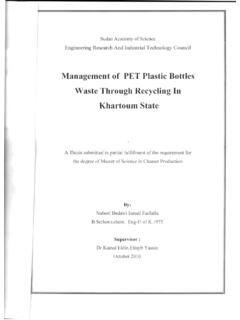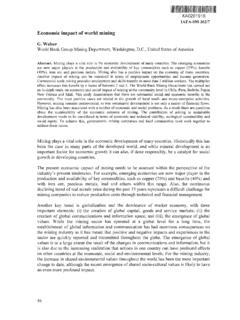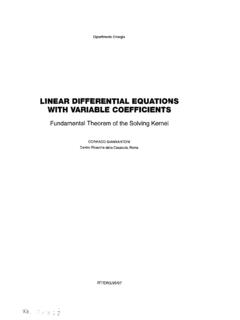Transcription of STUDYING THE VARIABLE REFRIGERANT VOLUME (VRV) …
1 STUDYING THE VARIABLE REFRIGERANT VOLUME (VRV) SYSTEM AND DETERMINING THE ROOT CAUSE OF ITS PROBLEM IN BUILDING 37, AGENSI NUKLEAR MALAYSIA PEMAHAMAN TENTANG SISTEM VARIABLE REFRIGERANT VOLUME (VRV) DAN MENGKAJI PUNCA MASALAH DI BANGUNAN 37, AGENSI NUKLEAR MALAYSIA Suhafizudin Bin Zainal Anuar, Mohamad Suhaimi Bin Yahaya, Jusnan Bin Hasim, Suhilah Binti Mohd Ali and Mohd Khafidz Bin Shamsuddin Bahagian Kejuruteraan, Agensi Nuklear Malaysia, Bangi, 43000 Kajang, Selangor Abstract VARIABLE REFRIGERANT VOLUME (VRV) system is one of the Heating, Ventilation and Air Conditioning (HVAC) type in the building. VRV system is a multi-split type air conditioner that uses VARIABLE REFRIGERANT flow control to provide customers with the ability to maintain individual zone control in each room and floor of a building.
2 VRV used in Building 37 is made by Mitsubishi Heavy Industries that was completely installed in 2011 with two pipes system format. The objectives of this study are to understand the VARIABLE REFRIGERANT VOLUME (VRV) system and also to study the root cause of its problem in Building 37, Agensi Nuklear Malaysia. The result of the study study suggests poor workmanship during installation process and insufficient electrical grounding are suspected as the causes of on-going and repeating problems occurred. Hence, Bahagian Kejuruteraan (BKJ) has worked out with the service contractor to identify the main problem and leaking area before proceeding with repair and commissioning activities. Abstrak Sistem VARIABLE REFRIGERANT VOLUME (VRV) adalah salah satu sistem untuk pemanasan, pengudaraan dan penyaman udara (HVAC) di dalam bangunan.
3 VRV adalah jenis penghawa dingin berasingan yang menggunakan kawalan aliran bahan pendingin yang boleh ubah untuk membolehkan pengguna mempunyai kemampuan mengawal suhu di bilik secara berasingan. VRV yang digunakan di Bangunan 37 dibuat oleh Mitsubishi Heavy Industries dan telah siap dipasang pada tahun 2011 dengan menggunakan sistem dua (2) paip. Objektif kajian ini adalah untuk memahami sistem VARIABLE REFRIGERANT VOLUME (VRV) dan mengkaji punca masalah VRV yang berlaku di Bangunan 37, Agensi Nuklear Malaysia. Hasil kajian ini mendapati kelemahan dalam mutukerja di peringkat pemasangan sistem ini dan pembumian elektrik yang tidak mencukupi adalah punca masalah yang berlanjutan serta berulangkali berlaku. Oleh yang sedemikian, BKJ telah berkerjasama dengan pihak kontraktor servis untuk mengenal pasti masalah utama dan kawasan kebocoran sistem ini sebelum aktiviti pembaikan dan mengujilari semula sistem ini dilakukan.
4 Keywords : VARIABLE REFRIGERANT VOLUME (VRV), VARIABLE REFRIGERANT Flow (VRF), Fan Coil Unit (FCU), Heating Ventilation Air Conditioning system (HVAC) INTRODUCTION VARIABLE REFRIGERANT VOLUME (VRV) system is a heating, ventilation and air conditioning (HVAC) technology that relatively new to the Malaysian market. Theoretically, VRV has a lot to offer in terms of efficiency, running costs, flexibility in use and control. As with any system, it suits some buildings, applications and climates better than others. In Nuclear Malaysia, VRV has been installed in Building 37 and 57 (Rumah Tamu) and been serviced monthly by service contractor. The objectives of this study are to understand the VARIABLE REFRIGERANT VOLUME (VRV) system and also to study the root cause of its problem in Building 37, Agensi Nuklear Malaysia BACKGROUND Building 37 or namely as Pembangunan Teknologi dan Kualiti (PTK) Building consists of 4 main floors as a part of facilities in providing public services, conducting research and consultation that related with nuclear technology in Malaysia.
5 There are 6 units of VRV outdoors to serve 56 units of VRV indoors. Besides VRV system, there are several numbers of air-cooled split unit and air-cooled split ducted that have been installed in Building 37 as a part of HVAC system. VRV Indoors unit that have been used are wall mounted, ceiling concealed, ceiling suspended and cassette type. VRV system used in Building 37 made by Mitsubishi Heavy Industries which completely installed in 2011 by NIATGA SDN BHD with 2 pipe system format. Table 1. Summary of VRV system in Building 37 Floor Outdoor Unit Outdoor Unit Model Power (HP) No. Indoor Unit Total Cooling Capacity (BTU/HR) 1st Floor CU-06 FDC560 KXRE6 20 6 198,800 1st Floor CU-05 FDC900 KXRE6 32 8 319,200 Basement 1 CU-04 FDC1010 KXRE6 36 14 357,800 Basement 1 CU-03 FDC850 KXRE6 30 12 301,100 Basement 2 CU-02 FDC504 KXRE6 18 10 198,800 Basement 3 CU-01 FDC504 KXRE6 18 6 178,900 Total 56 1,554,600 BKJ has observed VRV systems in building 37 which experience on-going problems, seeming to go from bad to worse.
6 Furthermore, the problems keep reported in Helpdesk system although the same problems have been resolved before. Most faults experienced on a VRV system will result in the complete system being out of action. With systems serving 6-14 indoor units, a fault on one unit could affect many people. As noted above, this adds severe pressure to get the problem fixed and the system operational as soon as possible. THEORY VARIABLE REFRIGERANT VOLUME (VRV) system is a multi-split type air conditioner. VRV has also been referred as VARIABLE REFRIGERANT Flow (VRF) that uses VARIABLE REFRIGERANT flow control to provide customers with the ability to maintain individual zone control in each room and floor of a building. The compressor unit is controlled by a VARIABLE -speed drive, which may operate more efficiently than conventional compressors of similar size.
7 VRV technology was invented in Japan by Daikin company in 1982. Nowadays, most of HVAC system manufactures have offer VRV systems to be used in mid and large size buildings. Figure 1 shows a typical layout of VRV system. Figure 1. Typical layout of VRV System VRV use REFRIGERANT as the cooling and heating medium. This REFRIGERANT is conditioned by a single outdoor condensing unit, and is circulated within the building to multiple fan-coil units (FCUs). Come in two system formats, two pipe and three pipe systems. In a two pipe system which commonly referred as heat pump system, all of the zones must either be all in cooling or all in heating. A three pipe Heat Recovery (HR) systems has the ability to simultaneously heat certain zones while cooling others.
8 That is means VRV systems have a unique ability to extract heat out of areas requiring cooling and put it into zones requiring heating. In both two-pipe and three-pipe systems with REFRIGERANT heat recovery, one or more heat recovery units are included between the compressor unit and the fan coil units. This unit controls the flow of liquid and vapour refrigerants between the fan coil units in heating or cooling mode, and minimizes the load on the compressor. Methods vary by manufacturers who provide their own valves, heat exchangers, controls and other components. Figure 2 includes simplified diagrams of two configurations with heat recovery. Figure 2. VRV Heat Recovery System Configuration Options METHODOLOGY The process flow chart of the study is described in fig.
9 3. Process 1 is the definition of the problem and objectives of the study. Then process 2 is the detail study of the basic understanding of the VARIABLE REFRIGERANT VOLUME (VRV) system and collects the relevant data from service report that had been prepared by contractor service. The next process is the analysis on the possible root cause with necessary evidence and theory before concluding the study. Figure 3. Flowchart of the methodology Heat Recovery Unit RESULTS AND DISCUSSION Advantages VRV system in the building can conserve space for installation. The space efficiency is enhanced by the compact size of the individual units, the long maximum piping length, and the ability to utilize a large scale air conditioning system with a single piping circuit.
10 Besides that, the system provides superior design flexibility especially in changing of layout that can be made easily. New compressor technology eliminates the need for piping calculations, which shortens the time needed for design. Outdoor units can be placed on the roof where they have no effect on the design of the building interior. The lightweight and compact units of VRV components can be transported using a regular lift. The pipes are few in number, making layout simpler. Hence, the technology in VRV system simplifies the installation process in term of time and cost. The figure 4 below shows an advantage of VRV system as compared with centralized air conditioning that using chilled water. Figure 4. Comparison of Chilled water central plant with VRV layout VRV delivers ultimate reliability of HVAC system in the building.










